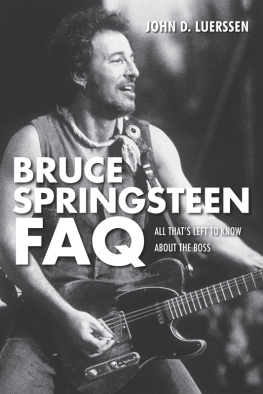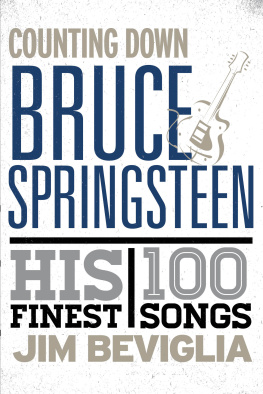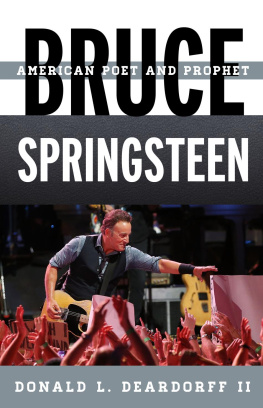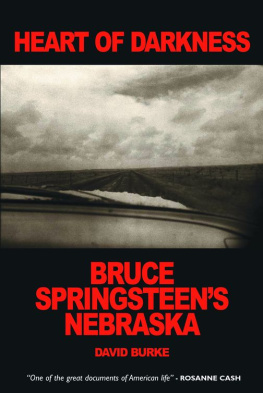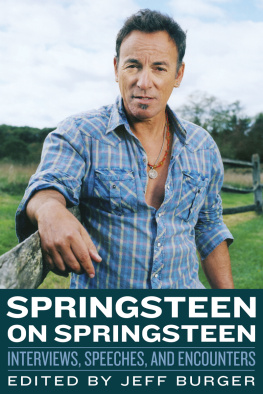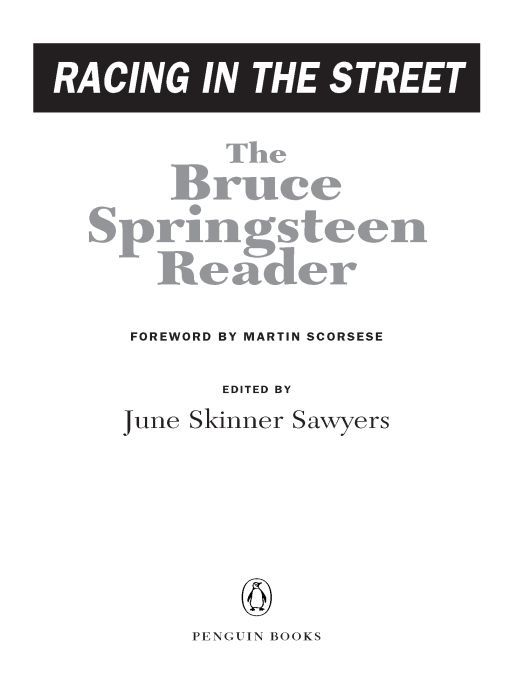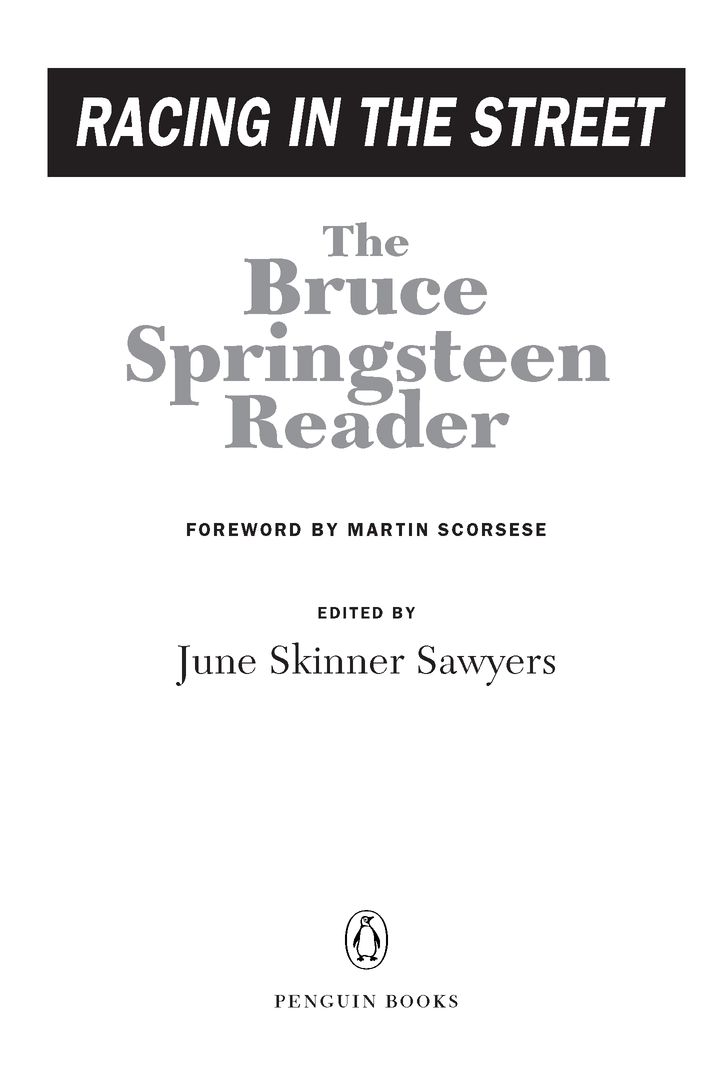Table of Contents
PENGUIN BOOKS
RACING IN THE STREET: THE BRUCE SPRINGSTEEN READER
Born in Glasgow, Scotland, June Skinner Sawyers has written extensively about music, travel, history, and popular culture. She contributes regularly to the Chicago Tribune and the San Francisco Chronicle and is an adjunct lecturer at the Newberry Library in Chicago. She is the author of numerous books, including Celtic Music: A Complete Guide, and has edited several literary anthologies, including Dreams of Elsewhere: The Selected Travel Writings of Robert Louis Stevenson; The Greenwich Village Reader; and The Road North: 300 Years of Classic Scottish Travel Writing. She lives in Chicago.
To
Asbury Park...
and, of course, the fans
The Springsteen Musical Family Tree
The Castiles
(1965 to 1966)
Bart Haynes: drums
Frank Marziotti: bass
Paul Popkin: guitar/vocals
Bruce Springsteen: guitar/vocals
George Theiss: guitar/vocals
The Castiles
(1966 to 1968)
Bob Alfano: organ
Curt Fluhr: bass
Vinny Maniello: drums
Paul Popkin: guitar/vocals
Bruce Springsteen: guitar/vocals
George Theiss: guitar/vocals
Earth
(1968)
Bruce Springsteen: guitar/vocals
John Graham: bass
Michael Burke: drums
Child
(1969)
Bruce Springsteen: guitar/vocals
Danny Federici: organ
Vini Lopez: drums
Vini Roslin: bass
Steel Mill
(1970)
Bruce Springsteen: guitar/vocals
Danny Federici: organ
Vini Lopez: drums
Steve Van Zandt: bass
Steel Mill
(1971)
Bruce Springsteen: guitar/vocals
Danny Federici: organ
Vini Lopez: drums
Robbin Thompson: guitar/vocals
Steve Van Zandt: bass
Dr. Zoom and the Sonic Boom
(1971-1972)
Bruce Springsteen: guitar/vocals
Kevin Connair: mc
Danny Federici: organ
Danny Gallagher: Monopoly
Vini Lopez: drums
David Sancious: keyboards
Southside Johnny: harmonica
Garry Tallent: bass
Bobby Williams: drums
Steve Van Zandt: guitar/vocals
The Zoomettes: vocals
The Bruce Springsteen Band
(1971)
Bruce Springsteen: vocals/guitar
Harvey Cherlin: trumpet
Francine Daniels: vocals
Barbara Dinkins: vocals
Bobby Feigenbaum: saxophone
Danny Federici: organ
Delores Holmes: vocals
Vini Lopez: drums
David Sancious: keyboards
Garry Tallent: bass
Steve Van Zandt: guitar/vocals
The E Street Band
(1972-1974)
Bruce Springsteen: vocals/guitar
Clarence Clemons: saxophone
Danny Federici: organ
Vini Lopez: drums
David Sancious: keyboards
Garry Tallent: bass
The E Street Band
(1974)
Bruce Springsteen: vocals/guitar
Ernest Boom Carter: drums
Clarence Clemons: saxophone
Danny Federici: organ
David Sancious: keyboards
Garry Tallent: bass
The E Street Band
(core members 1974-1984)
Bruce Springsteen: vocals/guitar
Roy Bittan: piano
Clarence Clemons: saxophone
Danny Federici: organ
Garry Tallent: bass
Steve Van Zandt: guitar/vocals
Max Weinberg: drums
The E Street Band
(core members 1984-2000)
Bruce Springsteen: vocals/guitar
Roy Bittan: piano
Clarence Clemons: saxophone
Danny Federici: organ
Nils Lofgren: guitar/vocals
Patti Scialfa: vocals
Garry Tallent: bass
Max Weinberg: drums
The E Street Band
(core members 2000-current)
Bruce Springsteen: vocals/guitar
Roy Bittan: piano
Clarence Clemons: saxophone
Danny Federici: organ
Nils Lofgren: guitar/vocals
Patti Scialfa: vocals
Garry Tallent: bass
Steve Van Zandt: guitar/vocals
Max Weinberg: drums
For a detailed description of Springsteens musical history, see The E Street Family Tree in Backstreets: SpringsteenThe Man and His Music, Charles R. Cross and the editors of Backstreets magazine (New York: Harmony Books, 1989; Crown, 1992), pp. 32-33.
NoteHaynes died in Vietnam.
Foreword
Martin Scorsese
Theres an epic vision at the heart of Bruce Springsteens music. Its evident in the breadth of American experience he covers in his songs, in the rich and colorful landscape of his music, in the unadorned beauty of his words. Its there in that voice of his, an instrument which has only grown more eloquent as the years have gone by. And that epic vision is there in the amazing range of emotions in his songsexhilaration, tragedy, desire, sorrow, hope, resignation, anger, betrayal, longing.
I heard Springsteen for the first time in the mid-70s. Like a lot of people, I was knocked out. There was no one else like him around at the time. The punk and New Wave explosions were happening here and in England, but that was a different kind of musicanarchic, relentlessly abrasive. Springsteen was something elsedeeply romantic, even extravagantly so. But he was also genuinely compassionatehere was a guy who really had a rock-solid commitment to working-class America and a feel for the lives of ordinary people: he gave their dreams and hopes the grandeur that they deserved. He was also a great showman, one of the greatest, as anyone who has ever seen one of his concerts can tell you. With the exception of solo projects like Nebraska and The Ghost of Tom Joad, every album seemed to encompass the entire history of rock and roll. Listen to Born to Run or Darkness on the Edge of Town or The River and youll hear blues, R&B, garage rock, folk, country, Motown, Phil Spector, pure pop, and more. Springsteen possesses an amazing generosityin the music, in the legendary performances, in his sense of social justice and his political outspokennessthats almost unmatched.
During the 70s, the word epiphany was used quite often by certain film criticsreferring to those moments when everything breaks through, when the audience finds itself delivered to a new and unexpected place by the artist, be it a filmmaker, a poet, a musician, or a writer. Springsteen, with his amazing E Street Band or off on his own, has given us many such moments. Born to Run is loaded with them. There was a time in 1975 when you could hear those songs blaring from car radios and apartment windows, and no matter how many times you listened to them, they never lost their edge: the moment in the title song when the band seems to push through to a new place, and Springsteen screams, The highways jammed with broken heroes on a last chance power drive; Randy Breckers mournful horn over the quietly tragic Meeting Across the River; the soaring climax of Jungleland. Springsteen had already made two beautiful albums before Born to Run, but that was the one that put him on the map, and it still has the same wild grandeur it had when it first hit the airwaves (and the turntables) almost thirty years ago.
There are many more artistic peaks, from Darkness on the Edge of Towns surprisingly quiet Racing in the Street to the heartbreaking Valentines Day from Tunnel of Love, a very underrated album, to the haunting song about 9/11, the title tune from The Rising. Youll read about many of these songs in this book, and if you werent around when they came out, youll find out what they meant to people, why they felt so special and so important, and so eternally fresh.


